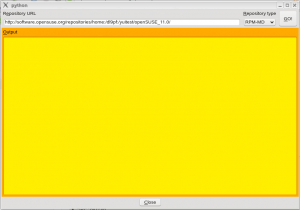During a last Hackweek I decided to work on some tool which will helps users with submitting a new bug. My idea is to create something like reportbug from Debian, but targeted to SUSE. So the first step was find the way how to communicate with a bugzilla (especially to bugzilla.novell.com – bnc). Fortunately I found several libraries, which should be used for it:
- perl-SUSE-BugzillaClient
- pybugz
- python-bugzilla
perl-SUSE-BugzillaClient is written by Thomas Schmidt especially for bnc, so it is able to login using iChain. It also provides few functions for bugzilla communication, but unfortunately only for querying. Pybugz is written by Alastair Tse for Gentoo development in Python. But it is not able to login through iChain and I did not extended it for bnc, because it uses a plain GET/POST communication with parsing of HTML using regexes.
The reason why I have used the python-bugzilla written by Will Woods from RedHat is simple. It uses XMLRPC API, which bugzilla provides. And it’s also written with a flexibility in mind, so writing of another type of Bugzilla was easy. Just some subclassing and reimplementing of few methods and voila, the NovellBugzilla type is here. Because it uses iChain, it was necessary to reimplement login/logout methods – I spend a lot of time to understand how it works. Osc uses a HTTP authentication, which should be supported too, but even if it works with api.opensuse.org, it did not work with bnc. So I used a Firefox and LiveHTTP headers extension to track a communication and implemented the login according it.
The useful advantage of Novell bugzilla is that I extended a method readconfig, which reads a config file. Novell Bugzilla can read the username/password from ~/.oscrc, so you don’t need to have a same password in another config file, if you use osc.
So on the end those few lines of Python code
import bugzilla
bnc = bugzilla.NovellBugzilla(url="https://bugzilla.novell.com", user="mvyskocil", password="XXXXX")
kwargs = {
'product': 'openSUSE 11.2',
'severity': 'Normal',
'cc': [],
'rep_platform': 'x86-64',
'component': 'Java',
'summary': '[Java:packages/ant]: Cannot find a Java virtual machine',
'version': 'unspecified',
'assigned_to': 'mvyskocil@novell.com',
'op_sys': 'Linux',
'description': 'This is a testing bug report\n'
}
bug = bnc.createbug(**kwargs)
print bug.bug_id
Have created this bug#525549. Even if Python is readable for regular programmers, the **kwargs should be expressed. It maps the dictionary to named function arguments (called keyword arguments – kwargs – in a Python world), so both calls in following snippet are equivalent.
d = {'name' : 'value')
call(**d)
call(name='value')
The python-bugzilla comes also with a simple command line tool called bugzilla, so this tool should be used also from shell scripts. It is sometimes little bit raw. For example listing of all products returns an output as a Python dictionary
bugzilla --bztype NovellBugzilla --user mvyskocil --password xxxxxx info -p
...
{'description': 'openSUSE 11.1', 'internals': {'disallownew': 0, 'classification_id': 7340, 'name': 'openSUSE 11.1',
'votestoconfirm': 0, 'milestone_required': 0, 'id': 651, 'votesperuser': 20, 'maxvotesperbug': 5, 'defaultmilestone': '---',
'milestoneurl': '', 'description': 'openSUSE 11.1'}, 'name': 'openSUSE 11.1', 'id': 651}
{'description': 'openSUSE 11.2', 'internals': {'disallownew': 0, 'classification_id': 7340, 'name': 'openSUSE 11.2',
'votestoconfirm': 0, 'milestone_required': 0, 'id': 755, 'votesperuser': 20, 'maxvotesperbug': 5, 'defaultmilestone': '---',
'milestoneurl': '', 'description': 'openSUSE 11.2'}, 'name': 'openSUSE 11.2', 'id': 755}
...
which might be hard to parse in other language. But it provides a lot of functionality, so for other informations about usage, please use man bugzilla.
 The
The 

